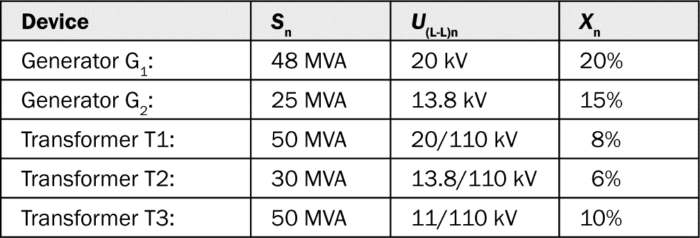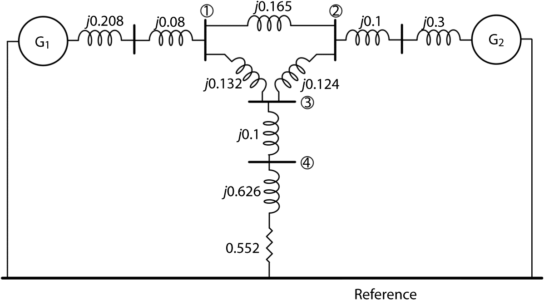The per unit (PU or P.U.) method of calculation is often used as an aid in the analysis of electrical systems that operate at different voltage levels. The determination of per unit values is not the end objective of a study. Rather determined per unit values serve to assist in the calculation of other system values. More specifically, the per unit method of calculation is often used in the calculation of short circuit currents.
The PU system of calculations was more prevalent in the past years. However, the availability of computer programs for system analysis has diminished to some extent the need for the PU system of calculations. Nevertheless, a person involved with three-phase electrical power would be well advised to understand the PU method, its mechanics, and how it is used.
The per unit method uses what are called base values. Selected values of parameters are compared to selected base values and assigned per unit values. The PU numbers become unitless.
A PU value can readily be converted back to a voltage, power, or any other value as long as the base value is known. Although the PU system could most likely be used for systems other than electrical systems, it is probably used mostly with electrical values.
The PU system deals primarily with values of power, voltage, current, and impedance. Any two variables are selected to be base values. The selection of two base values then fixes the other values. A per unit quantity then becomes the ratio of a selected parameter to a selected base value. Basically,
Per Unit = (Present value) ÷ (base value)
Per Unit values are sometimes expressed as a percentage rather than a ratio. For example, if the base value of voltage had been selected as 13,800 V and the present value is 11,000 V, the value of voltage per unit is
VPU = 11,000 ÷ 13,800 = 0.797 PU, or
VPU = 0.797 (100) = 79.7% PU
Often, nameplate values are taken as base values but this need not be the case. Some basic relationships follow and are different for single-phase systems and three-phase systems.
Single Phase Per Unit System
Typically,
Pbase = 1 PU
Vbase = 1 PU
Let,
Qbase = reactive power
Sbase = apparent power
The remainder of the values may be derived from the normal relationships
\[\begin{array}{*{35}{l}} S\text{ }=\text{ }IV \\ P\text{ }=\text{ }S\text{ }cos\text{ }\varphi \\ Q\text{ }=\text{ }S\text{ }sin\text{ }\varphi \\ V\text{ }=\text{ }I\cdot Z \\ Z\text{ }=\text{ }R\text{ }+\text{ }jX \\ {{I}_{base}}\text{ }=\frac{{{S}_{base}}}{{{V}_{base}}} \\ ~{{Z}_{base}}\text{ }=\frac{{{V}_{base}}}{{{I}_{base}}}\text{ }=\frac{V_{base}^{2}}{{{S}_{base}}} \\ {{Y}_{base}}\text{ }=\text{ }\frac{1}{{{Z}_{base}}} \\\end{array}\]
Three Phase Per Unit System
In three-phase circuits, some relationships are defined differently from those used in single-phase circuits. Specifically, for three-phase systems,
${{S}_{base}}=\sqrt{3}{{V}_{base}}.{{I}_{base}}$
\[{{I}_{base}}=\frac{{{S}_{base}}}{{{V}_{base}}\times \sqrt{3}}\]
\[{{Z}_{base}}=\frac{{{V}_{base}}}{{{I}_{base}}\times \sqrt{3}}=\frac{V_{base}^{2}}{{{S}_{base}}}\]
\[{{Y}_{base}}=\frac{1}{{{Z}_{base}}}\]
In general, the per unit values are determined as
$\begin{align} & {{V}_{pu}}=\frac{V}{{{V}_{base}}} \\ & {{I}_{pu}}=\frac{I}{{{I}_{base}}} \\ & {{S}_{pu}}=\frac{S}{{{S}_{base}}} \\ & {{P}_{pu}}=\frac{P}{{{P}_{base}}} \\ & {{Z}_{pu}}=\frac{Z}{{{Z}_{base}}} \\ & {{Y}_{pu}}=\frac{Y}{{{Y}_{base}}} \\\end{align}$
To change base values, the following expression is used:
\[{{Z}_{pu-new}}={{Z}_{pu-old}}\times \left( \frac{{{S}_{base-new}}}{{{S}_{base-old}}} \right){{\left( \frac{{{V}_{base-old}}}{{{V}_{base-new}}} \right)}^{2}}\]
Per Unit System Example of Three Phase System
Consider a three-phase transformer with a rating of 700 MVA and a secondary voltage of 145 kV. Determine Ibase, Zbase, and Ybase.
There is no obligation to choose the transformer’s ratings as the base values, but it is an option.
Using the transformer’s rated values of apparent power and secondary voltage,
Sbase = 700 MVA
Vbase = 145 kV
The corresponding values of Ibase, Zbase, and Ybase are readily determined.
\[{{I}_{base}}=\frac{{{S}_{base}}}{{{V}_{base}}\times \sqrt{3}}=\frac{700MVA}{145kV\times \sqrt{3}}=2.78kA\]
\[{{Z}_{base}}=\frac{{{V}_{base}}}{{{I}_{base}}\times \sqrt{3}}=\frac{145kV}{2.78kA\times \sqrt{3}}=30.1\Omega \]
\[{{Y}_{base}}=\frac{1}{30.1}=0.0332S\]
If, say, a secondary voltage of 130 kV is under consideration, then the per unit value of that voltage is
\[V=\frac{V}{{{V}_{base}}}=\frac{130kV}{145kV}=0.89pu\]
Per Unit System Example 2
The single-line diagram of a three-phase system is shown in Fig. 1. Using the common base Sb = 50 MVA, draw the impedance diagram in per unit including the load impedance. The manufacturer’s nominal ratings are given as follows:

FIGURE 1 Single-line diagram of Example 1.

The three-phase load at bus 4 absorbs 60 MVA at 0.75 power factor (lagging), and lines 1, 2, and 3 have the reactance of 40Ω, 32 Ω, and 30Ω, respectively.
Solution The system of Fig. 1 can be subdivided into different sections with different voltage levels determined by the transformer turns ratios. A common power base of ${{S}_{b}}=50MVA$ is chosen for the system, but the voltage bases are selected separately for each voltage level:
Voltage base for buses 1, 2, and 3:${{V}_{b}}\left( 1 \right)={{V}_{b}}\left( 2 \right)={{V}_{b}}\left( 3 \right)=110kV$
Voltage base for bus 4: ${{V}_{b}}\left( 4 \right)=11kV$
Per-unit reactances of the generators and transformers are
\[\begin{align} & \begin{matrix} {{G}_{1}}: & {{X}_{G1}}=0.2\times \frac{50}{48}=0.0208pu \\\end{matrix} \\ & \begin{matrix} {{G}_{2}}: & {{X}_{G2}}=0.15\times \frac{50}{25}=0.3pu \\\end{matrix} \\ & \begin{matrix} {{T}_{1}}: & {{X}_{T1}}=0.08\times \frac{50}{50}=0.08pu \\\end{matrix} \\ & \begin{matrix} {{T}_{2}}: & {{X}_{T2}}=0.6\times \frac{50}{30}=0.1pu \\\end{matrix} \\ & \begin{matrix} {{T}_{3}}: & {{X}_{T3}}=0.1\times \frac{50}{50}=0.1pu \\\end{matrix} \\\end{align}\]
The impedance bases for lines 1, 2, and 3 are
\[{{Z}_{b\left( L1 \right)}}={{Z}_{b\left( L2 \right)}}={{Z}_{b\left( L3 \right)}}=\frac{{{\left( 110 \right)}^{2}}}{50}=242\Omega \]
The per-unit reactances of lines 1, 2, and 3 are
\[\begin{align} & \begin{matrix} {{L}_{1}}: & {{X}_{L1}}=\frac{40}{242}=0.165pu \\\end{matrix} \\ & \begin{matrix} {{L}_{2}}: & {{X}_{L2}}=\frac{32}{242}=0.132pu \\\end{matrix} \\ & \begin{matrix} {{L}_{3}}: & {{X}_{L3}}=\frac{30}{242}=0.124pu \\\end{matrix} \\\end{align}\]
The power factor of the load is cos $\cos \varphi =0.75$ lagging; thus, the complex power of the load is ${{S}_{L}}=60\angle {{\cos }^{-1}}0.75=60\angle {{41.41}^{o}}MVA$ . Hence, the load impedance in Ω is
\[{{Z}_{Load}}=\frac{{{V}^{2}}}{S_{L}^{*}}=\frac{{{11}^{2}}}{{{\left( 60\angle {{41.41}^{o}} \right)}^{*}}}=\frac{{{11}^{2}}}{60\angle -{{41.41}^{o}}}=2.02\angle -{{41.41}^{o}}=1.515+j1.336\Omega \]
The base impedance for the load is
\[{{Z}_{b\left( bus4 \right)}}=\frac{{{11}^{2}}}{50}=2.42\Omega \]
The per-unit load impedance is
\[{{Z}_{Load}}=\frac{1.515+j1.336}{2.42}=0.626+j0.552pu\]
The impedance diagram of the system with all reactances in PU is plotted in Fig. 2.

FIGURE 2 Per-phase equivalent impedance diagram for the system shown in Fig. 1.
For either a single-phase system or a three-phase system, the per units become
$\begin{align} & {{V}_{pu}}=\frac{V}{{{V}_{base}}} \\ & {{I}_{pu}}=\frac{I}{{{I}_{base}}} \\ & {{S}_{pu}}=\frac{S}{{{S}_{base}}} \\ & {{Z}_{pu}}=\frac{Z}{{{Z}_{base}}} \\\end{align}$
In all of these expressions, the numerator is a complex vector, whereas the denominator is a real number. For base values, a value of Sbase = 50 or 100 MVA is often selected. For in-house electrical systems, a base of Sbase = 10 MVA is more suitable as the VA values are generally smaller than the VA of overland transmission lines. For transmission lines, 100 MVA is often used. Nevertheless, any value of S may be used.
Advantages of PU System
There are many advantages to use the per-unit system in power network engineering as such representation results in more correlated and meaningful data. Some of these advantages are highlighted as follows:
- Manufacturers usually provide equipment data with nameplate rating as a base.
- The range for acceptable % or p.u. values can be easily fixed.
- Especially useful in networks with multiple voltage levels interconnected through transformers.
- PU impedance of the transformer is independent of the kV base.
- Standard base conversion (scaling with MVA Base) formulae are available.
- While the actual values of the impedances of power system equipment, expressed in ohms, may vary over a wide range, depending on their rating, their per-unit values are restricted to a narrow range whatever the rating may be.
- Per-unit impedances of transformers are the same whether they are referred to the primary or secondary side, which makes calculations much simpler in multiple voltage level power systems.
- In equations to calculate power and voltage in three-phase systems, the factors $\sqrt{3}$ and 3 are eliminated using the PU system. This way, there is less chance of confusing line and phase voltages as well as between single- and three-phase power systems.
- The PU system is very useful for computer-performed calculations concerning steady-state and dynamic analysis.
Per Unit System Summary
Modern power systems comprise several transmission lines interconnected in subsystems of different voltage levels through various step-up or step-down transformers. However, this makes it difficult to figure out the various voltage and power levels at different points in the network. To overcome this problem, all the system quantities are converted into a uniform normalized platform called per-unit.
The per-unit representation of physical values consists in expressing these values as fractions or percentages of some representative bases of the same physical nature. In a per-unit system, each system variable or quantity is normalized with respect to its own base value:
\[{{X}_{pu}}=\frac{{{X}_{actual}}}{{{X}_{base}}}\]
Or
\[{{X}_{pu}}=\frac{{{X}_{actual}}}{{{X}_{base}}}\times 100%\]
Four base quantities, namely power, voltage, current, and impedance, are necessary for the full description of a per-unit system. However, because they are interrelated, selecting base values for any two of them determines the base values of the remaining two. Usually, power, Sb, and voltage, Vb, are chosen as base values for computing the current, Ib, and impedance, Zb, bases:
\[{{I}_{b}}=\frac{{{S}_{b\left( 3\varphi \right)}}}{\sqrt{3}{{V}_{b\left( L-L \right)}}}\]
\[{{Z}_{b}}=\frac{{{\left( {{V}_{b\left( L-L \right)}}\text{ in kV} \right)}^{2}}}{{{S}_{b\left( 3\varphi \right)}}\text{ in MVA}}\]
Generally, Sb(3Φ) is the three-phase apparent power base, which is the same for the entire network. Vb(L-L) is the line-to-line base voltage, which is not constant for the entire network. It is a factor of the transformer ratios. The nominal characteristics (ratings) of power transmission equipment, for example, generators and transformers, are provided by manufacturers in percent or per-unit quantities based on their own ratings. It is often convenient to express these values in a common system basis.